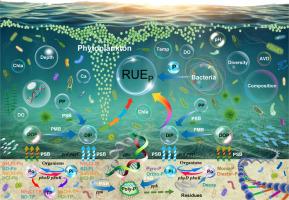Bacterially mediated phosphorus cycling favors resource use efficiency of phytoplankton communities in a eutrophic plateau lake
IF 11.4
1区 环境科学与生态学
Q1 ENGINEERING, ENVIRONMENTAL
引用次数: 0
Abstract
Resource use efficiency has garnered much attention globally owing to its linkage with phytoplankton growth and extinction. However, little is known about how microbially mediated phosphorus (P) cycling affects phytoplankton P resource use efficiency (RUEP), especially in eutrophic plateau lakes. Here, we studied the vertical relationship between bacterial communities and phytoplankton RUEP in water profiles from Hongfeng Lake, a eutrophic lake located in the Guizhou Plateau, and further revealed the influence of bacterially mediated endogenous P release on phytoplankton RUEP. Generally, phytoplankton RUEP increased slightly and then decreased toward deep water layers. Compared to dormancy and recovery periods, outbreak period showed higher RUEP in water profiles and bottom waters. The importance of phytoplankton RUEP in the co-occurrence networks progressively increased from dormancy to outbreak periods. Rhodococcus may affect phytoplankton RUEP in water profiles by dissolving Ca-P or polymerizing excess phosphate. Functional composition of P-related genes was largely affected by NH4Cl-Po, BD-TP and BD-Pi in recovery period, and by NaOH-Po in outbreak period. During phytoplankton growth, bacterial P functional genes promote phytoplankton RUEP mainly by regulating Pi solubilization and Po mineralization in surface sediments. Note that ppk could regulate the formation of polyphosphates and thus reduce phytoplankton RUEP. Taken together, our study revealed the relationship between bacterially mediated P cycling and phytoplankton RUEP, which can effectively monitor the potential risk of phytoplankton blooms and improve eutrophication management.


求助全文
约1分钟内获得全文
求助全文
来源期刊

Water Research
环境科学-工程:环境
CiteScore
20.80
自引率
9.40%
发文量
1307
审稿时长
38 days
期刊介绍:
Water Research, along with its open access companion journal Water Research X, serves as a platform for publishing original research papers covering various aspects of the science and technology related to the anthropogenic water cycle, water quality, and its management worldwide. The audience targeted by the journal comprises biologists, chemical engineers, chemists, civil engineers, environmental engineers, limnologists, and microbiologists. The scope of the journal include:
•Treatment processes for water and wastewaters (municipal, agricultural, industrial, and on-site treatment), including resource recovery and residuals management;
•Urban hydrology including sewer systems, stormwater management, and green infrastructure;
•Drinking water treatment and distribution;
•Potable and non-potable water reuse;
•Sanitation, public health, and risk assessment;
•Anaerobic digestion, solid and hazardous waste management, including source characterization and the effects and control of leachates and gaseous emissions;
•Contaminants (chemical, microbial, anthropogenic particles such as nanoparticles or microplastics) and related water quality sensing, monitoring, fate, and assessment;
•Anthropogenic impacts on inland, tidal, coastal and urban waters, focusing on surface and ground waters, and point and non-point sources of pollution;
•Environmental restoration, linked to surface water, groundwater and groundwater remediation;
•Analysis of the interfaces between sediments and water, and between water and atmosphere, focusing specifically on anthropogenic impacts;
•Mathematical modelling, systems analysis, machine learning, and beneficial use of big data related to the anthropogenic water cycle;
•Socio-economic, policy, and regulations studies.
 求助内容:
求助内容: 应助结果提醒方式:
应助结果提醒方式:


